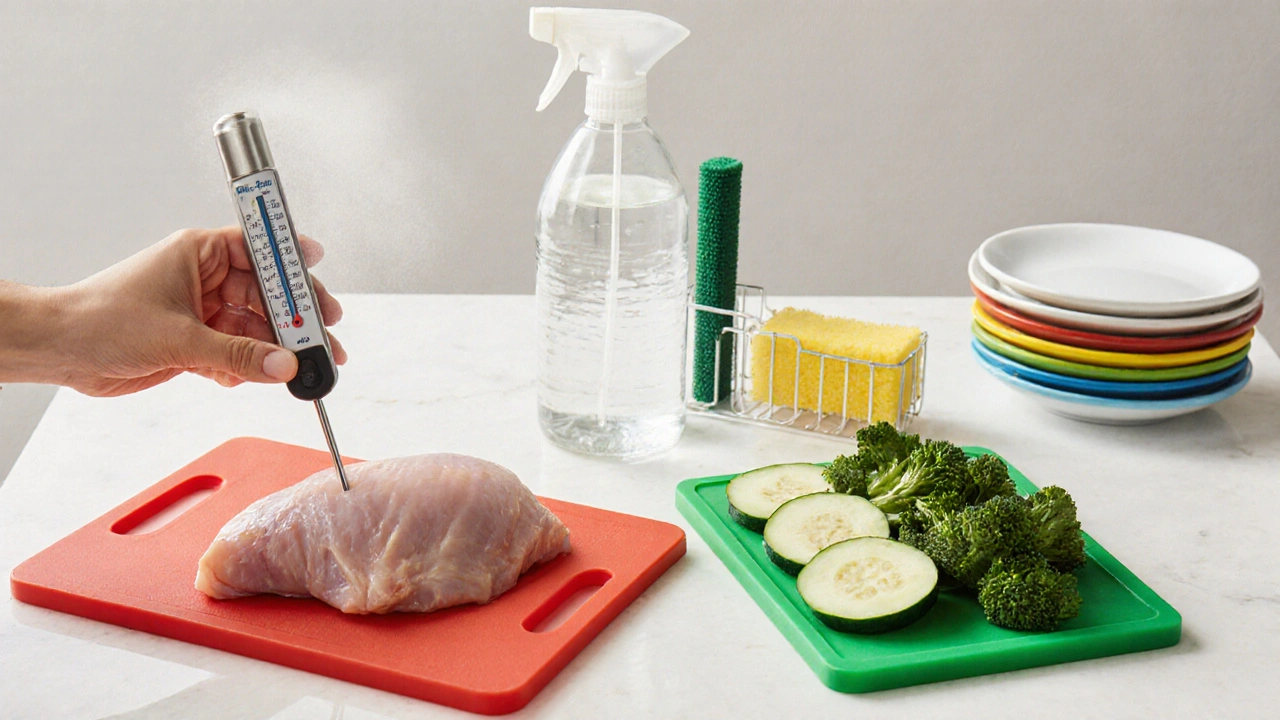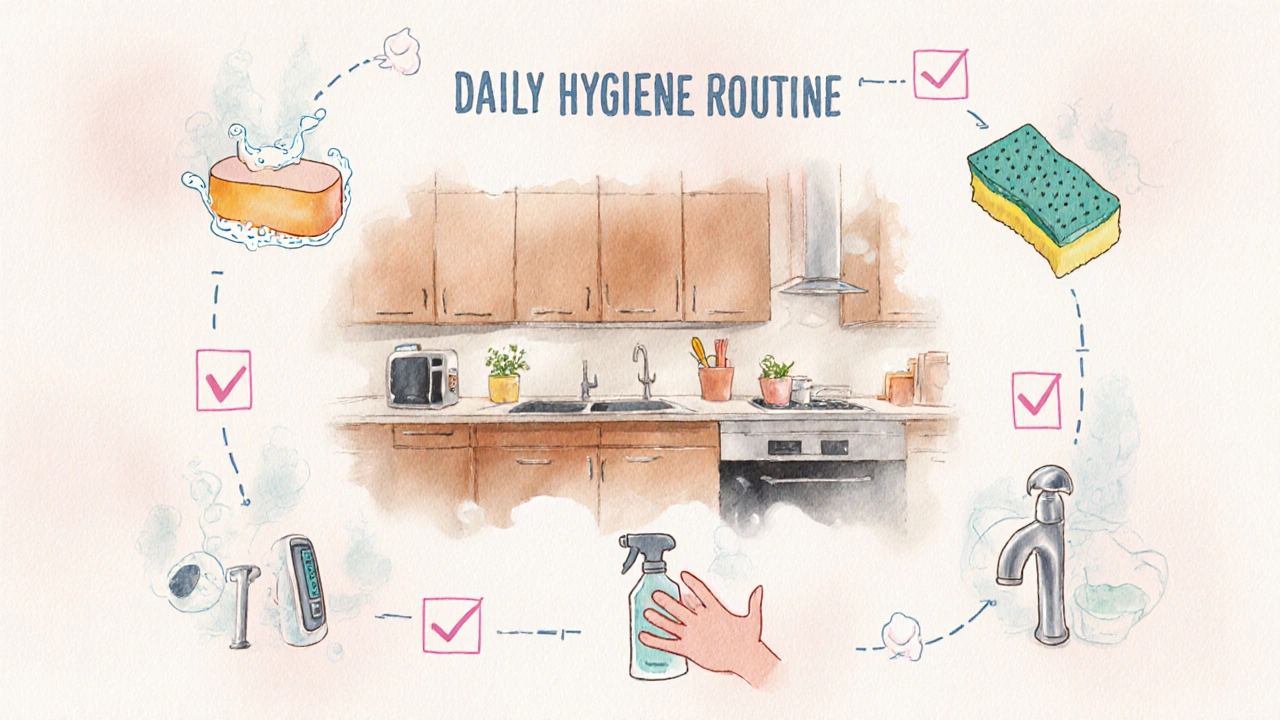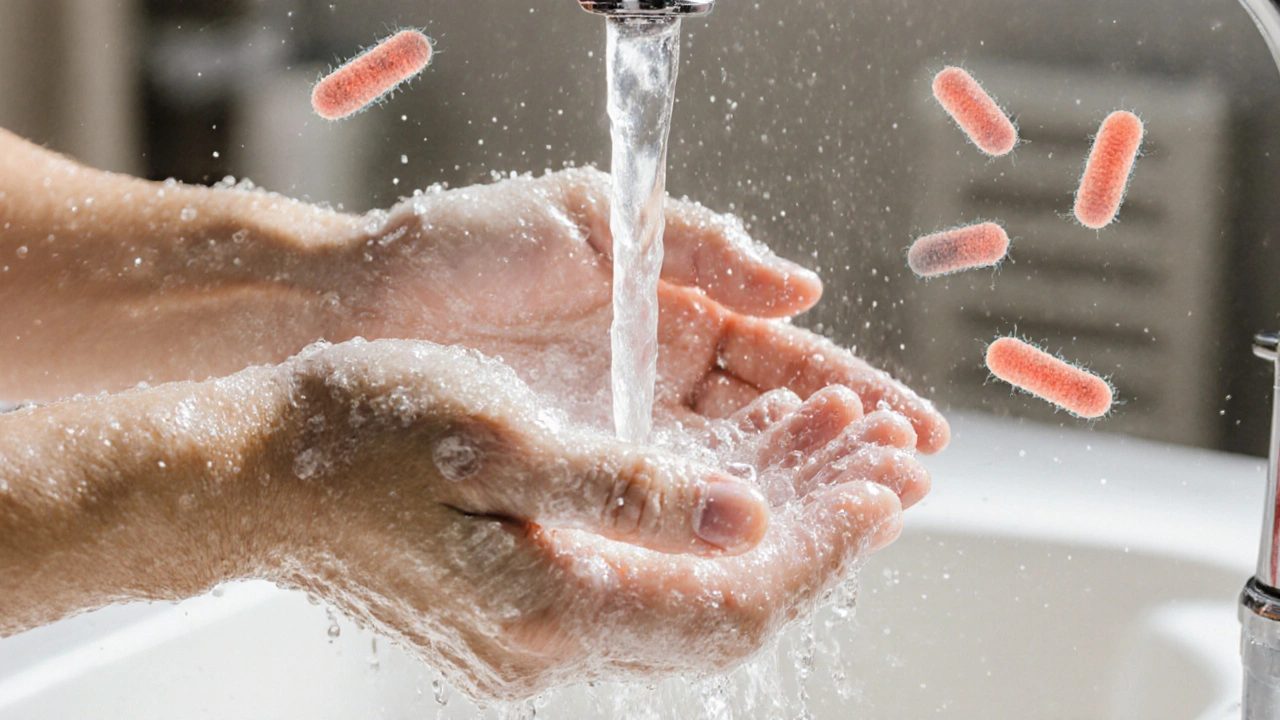Salmonella Risk Reduction Calculator
Select the hygiene practices you follow regularly to calculate your potential risk reduction against salmonella infections.
Your Current Risk Reduction
Select Your Hygiene Practices:
Hand Washing
20-second soap and water technique
Surface Sanitizing
Bleach solution or disinfectant
Separate Cutting Boards
Color-coded boards for raw and cooked foods
Proper Cooking
Reach 75°C (167°F) internal temp
Replace Sponges
Weekly replacement or microwaving
Your Risk Reduction Summary
Select hygiene practices above to see your personalized risk reduction summary.
Key Takeaways
- Salmonella spreads mainly through contaminated hands, food, and surfaces.
- Proper personal hygiene can cut the risk of infection by up to 70%.
- Critical steps include thorough hand washing, kitchen sanitation, and cooking foods to safe temperatures.
- Use the checklist at the end to audit your daily routines.
- Common myths-like "cooking kills all germs"-are debunked with real data.
What is Salmonella?
When you hear "Salmonella is a group of rod‑shaped bacteria that cause foodborne illness, think of a microscopic culprit that loves warm, moist environments. In the UK, the Food Standards Agency reports about 30,000 cases each year, ranging from mild stomach upset to severe dehydration.
How Does Salmonella Spread?
The bacteria travel on three main highways:
- Hands: Touching raw meat, eggs, or contaminated surfaces, then handling ready‑to‑eat foods.
- Cross‑contamination: (Cross‑contamination is the accidental transfer of pathogens from one food or surface to another) Using the same cutting board for chicken and salad without washing.
- Improper cooking: Not reaching the internal temperature needed to kill the bacteria.
Remember, the bacteria can survive on kitchen sponges for weeks, making routine cleaning crucial.

Why Personal Hygiene Matters
Good hygiene isn’t just about looking clean; it creates a barrier that stops salmonella before it even reaches food. Studies from the CDC show that consistent hand washing reduces gastrointestinal infections by about 40%, while combined kitchen hygiene can push that reduction over 70%.
Effective Hygiene Practices
Below are the habits that directly attack salmonella’s weak points.
1. Hand Washing (The Gold Standard)
Hand washing is the act of cleaning hands with soap and water for at least 20 seconds. Follow the WHO six‑step method:
- Wet hands under running water (preferably warm).
- Apply enough liquid soap to cover all surfaces.
- Rub palms together, then interlace fingers.
- Scrub the backs of hands and thumbs.
- Rinse thoroughly.
- Dry with a single‑use paper towel; use the towel to turn off the tap.
Do this before and after handling raw meat, after using the toilet, and after touching pets.
2. Kitchen Surface Sanitization
Use a solution of 1 tablespoon bleach per liter of water or an EPA‑approved disinfectant. Wipe cutting boards, countertops, and refrigerator handles after each use. Replace sponges every few days; microwave a damp sponge for 1 minute to kill lingering germs.
3. Food‑Specific Practices
Food safety is the set of practices that prevent contamination and ensure safe consumption includes:
- Separate raw meat from ready‑to‑eat foods using different plates.
- Store poultry and eggs on the bottom shelf to prevent drips.
- Thaw frozen foods in the fridge, not on the counter.
4. Cooking Temperatures
Cooking temperature is the internal heat level required to kill harmful bacteria for chicken, turkey, and eggs should reach 75°C (167°F). Use a calibrated food thermometer-guesswork leads to 30% more infection risk.
5. Bathroom Hygiene
Always wash hands after using the toilet and after changing diapers. Keep toilet seats clean with a disinfectant wipe weekly. In shared bathrooms, provide a hand‑drying station to avoid re‑contamination.
Impact of Hygiene Practices on Salmonella Risk
| Practice | % Risk Reduction | Recommended Frequency |
|---|---|---|
| Hand washing (20‑sec soap) | 40% | Before/after food prep, after restroom |
| Surface sanitizing (bleach solution) | 25% | After each raw meat handling |
| Separate cutting boards | 15% | Always |
| Cook to 75°C (165°F) | 30% | Every meal with poultry/eggs |
| Replace sponges weekly | 10% | Weekly |
Adding these steps together can push overall protection well beyond 70% when followed consistently.

Household Hygiene Checklist
- Wash hands for 20 seconds before cooking, after using the bathroom, and after handling pets.
- Keep raw meat on a separate plate; use color‑coded cutting boards.
- Sanitize countertops and knives after each raw‑food session.
- Check internal temperature of poultry with a thermometer.
- Replace kitchen sponges or microwave them weekly.
- Disinfect bathroom handles and faucet knobs daily.
- Store leftovers in shallow containers within two hours of cooking.
Common Myths Debunked
Myth: "If food looks and smells fine, it’s safe." Reality: Salmonella doesn’t change the appearance or smell of food. Rely on temperature, not senses.
Myth: "Soap isn’t necessary; water alone works." Reality: Soap lifts grease and microbes from skin. Water alone removes only a fraction.
Myth: "Washing chicken kills germs." Reality: Rinsing spreads bacteria to sinks and countertops, increasing cross‑contamination risk.
Frequently Asked Questions
Can I get salmonella from vegetables?
Yes. Leafy greens can become contaminated through irrigation water or handling. Wash them under running water and, when possible, use a produce‑specific brush.
How long does salmonella survive on kitchen surfaces?
It can live for days on dry surfaces and weeks on moist sponges. Regular disinfection is essential.
Is a dishwasher enough to sanitize dishes?
Modern dishwashers reaching 70°C (158°F) are effective, but pre‑rinsing heavily soiled plates reduces the bacterial load further.
What symptoms should make me see a doctor?
High fever, persistent diarrhea lasting more than three days, or blood in stool require medical attention, especially for children and the elderly.
Do probiotic foods help after a salmonella infection?
Probiotics can aid gut recovery, but they should complement, not replace, rehydration and any prescribed antibiotics.

Elizabeth Post
October 10, 2025 AT 15:14Great rundown on why washing those hands matters more than you think. Keeping a 20‑second routine can actually shave off a huge chunk of the risk. The checklist at the end is super handy for a quick daily audit. Remember to swap out sponges regularly – they’re a hidden breeding ground. Stick to the schedule and you’ll feel a lot more confident in the kitchen.
Brandon Phipps
October 22, 2025 AT 05:01Totally agree with the emphasis on hand washing, and let me add a few extra thoughts. First, the water temperature doesn’t have to be scorching; warm is enough to help soap break down fats. Second, the WHO six‑step method is easy to remember once you practice it daily, and you’ll notice fewer sticky residues after cooking. Third, using a paper towel to turn off the faucet prevents re‑contamination in a single motion. Fourth, consider keeping a small bottle of hand sanitizer nearby for those moments when you’re rushed, though it’s not a substitute for proper washing. Fifth, the table showing 40% risk reduction for hand washing lines up well with CDC data that highlights a 30‑40% drop in gastrointestinal infections. Sixth, many people underestimate the power of a clean cutting board – color‑coded boards reduce cross‑talk between raw and ready‑to‑eat foods, which is a game‑changer. Seventh, cleaning surfaces with a bleach solution after each raw meat prep feels like a chore, but it builds a solid barrier of safety. Eighth, microwaving a damp sponge for a minute is a clever hack that kills hidden microbes without buying a new one every week. Ninth, using a calibrated food thermometer isn’t just for meat; it’s also crucial for checking the internal temp of egg dishes. Tenth, the 75°C rule is non‑negotiable if you want to eliminate salmonella efficiently. Eleventh, disinfecting bathroom handles daily helps close another infection loop that many overlook. Twelfth, storing leftovers in shallow containers speeds up cooling and reduces bacterial growth. Thirteenth, the myth busting section is spot‑on – visual cues aren’t reliable indicators of safety. Fourteenth, probiotic foods can help rebalance gut flora after an infection, but they don’t replace rehydration. Fifteenth, overall, the layered approach of combining hand hygiene, surface sanitizing, proper cooking, and regular sponge replacement creates a cumulative risk reduction that easily surpasses 70% when applied consistently.
yogesh Bhati
November 2, 2025 AT 18:48Yo, ever think about how a tiny bit of soap is like a tiny philospher whispering to germs? The act of washing is more than just cleaning, it's a ritual of defying invisible invaders. When you scrub those palms you actually write a short story of survival on your skin. If you skip it, those little critters get a free ride to your dinner plate. Stay mindful, stay clean – it's a simple everyday enlightenment.
Akinde Tope Henry
November 14, 2025 AT 08:34Good point but your soap story is overblown keep it simple wash hands for twenty seconds no drama.
Brian Latham
November 25, 2025 AT 22:21Meh looks like a lot of hassle.